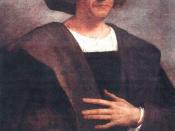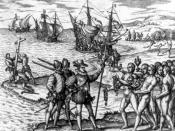Essay 2
After reading on the invasion of the America's it was clear that the book contained a lot of European ethnocentrism. The chapter was based on Calloway's point of view as to what happened. He had a lot of testimonies that came from different European soldiers as to what they felt the Indians experienced. In order to not have the European ethnocentrism Calloway needed to include the Indians point of view as well. He somehow needed to obtain testimony or documents that were written by the Indians'. Calloway did try to give the point of views of what the soldiers thought the Indians felt but it still didn't give the same effect that we would have gotten if it came straight from the Indians themselves. The chapter starts out by discussing some of the routes that were taken to reach the America's by different countries that sought out to create new colonies.
It told about Christopher Columbus's second voyage to Hispaniola and his treatment of the Indians. With this voyage to Hispaniola, Christopher Columbus brought along with him 17 other ships to start a colony. This would have been a great opportunity for Calloway to include the Indian's perspective of how they felt about Christopher Columbus creating a colony in Hispaniola, and what they thought about him starting to make slaves out of the Indians. Instead of giving the readers that perspective Calloway immediately goes on to a different topic in the chapter. Another example of European ethnocentrism in the chapter takes place when Calloway tells about how disease was the deadliest import that the Indian's faced. Calloway goes on to state "Epidemics of smallpox, measles, bubonic plague, influenza, cholera, and other killer diseases spread like wildfire through Indian societies. Different diseases struck different regions at different times, and...


